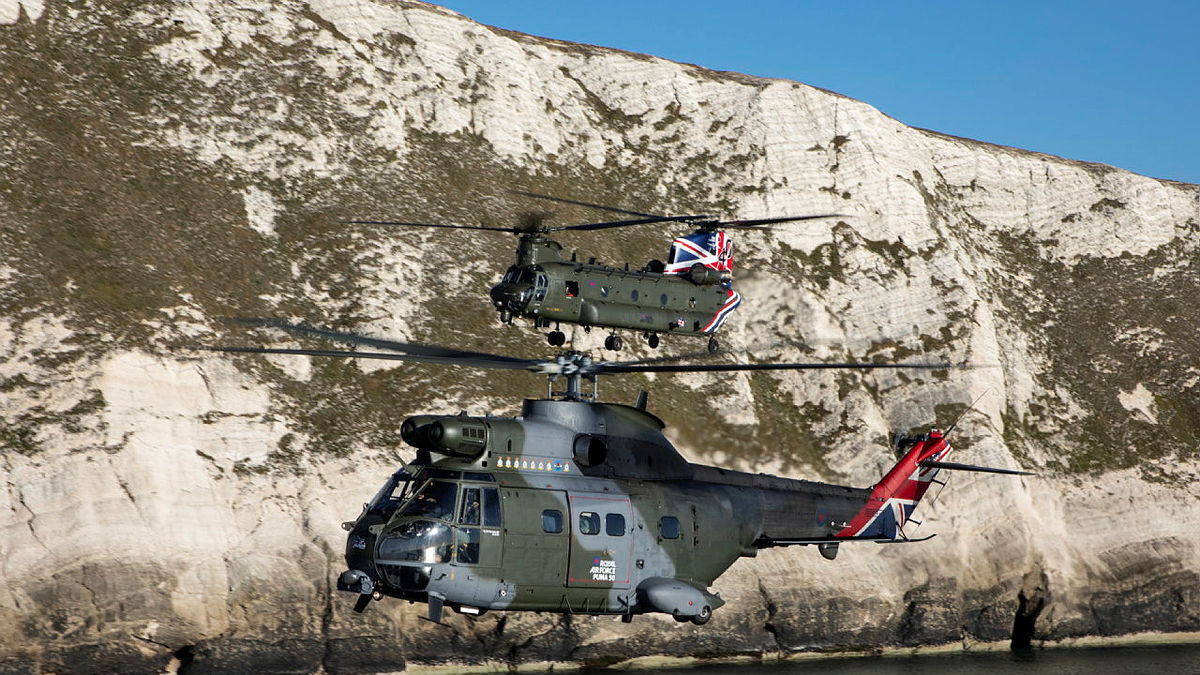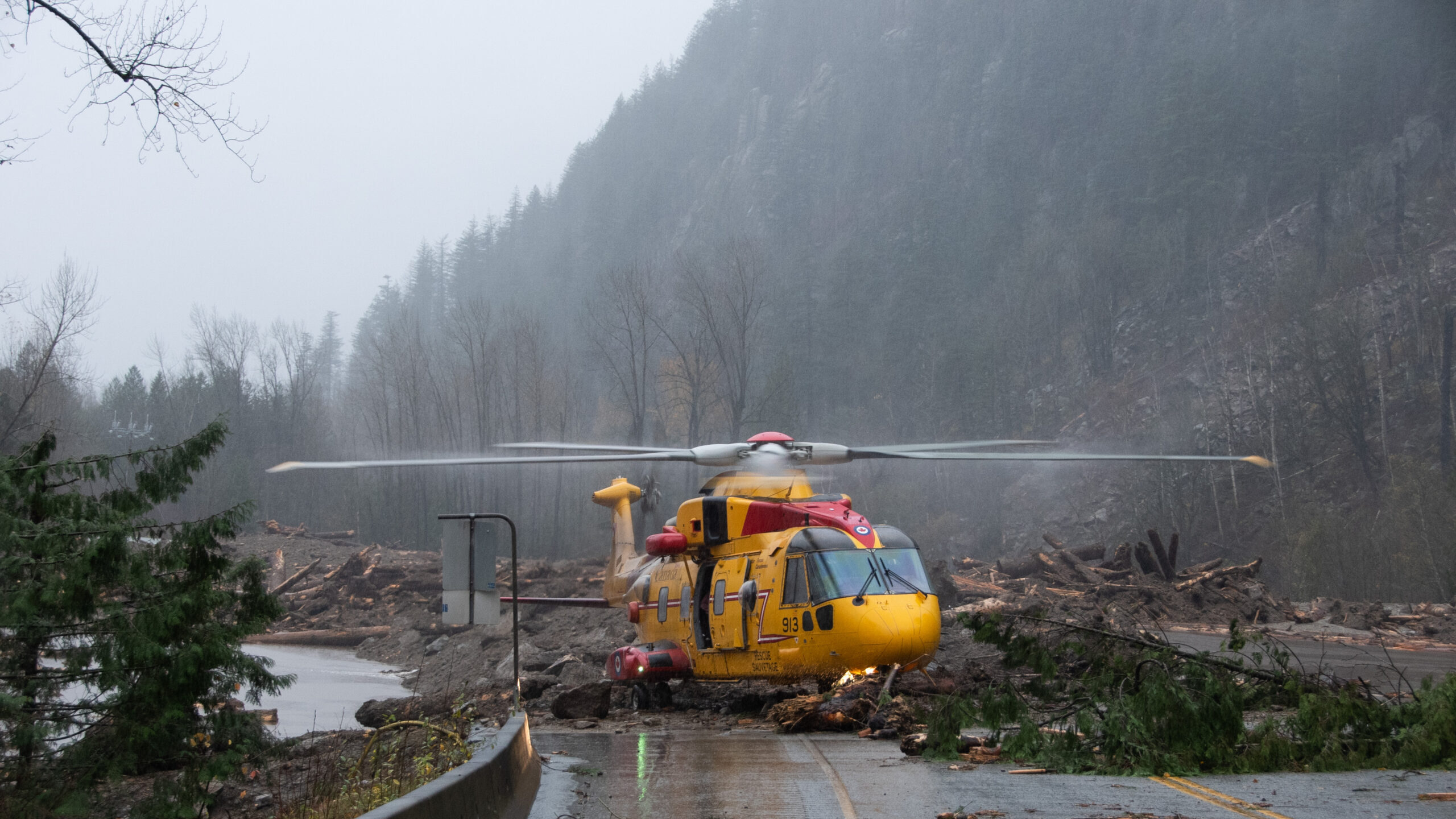
The RAF’s Puma helicopter (pictured in the foreground) fleet is set to be out of service in 2025 and replaced with a new aircraft as part of a $1.24 billion acquisition (UK MoD)
UPDATED Jan. 20 at 5.47am ET to clarify Leonardo’s involvement in the European Union funded Next Generation Rotorcraft Technology program
BELFAST — One of the competitors in the UK’s £1 billion ($1.24 billion) New Medium Helicopter procurement warned that the “longer negotiations take” with the Ministry of Defence, the harder it will prove for industry to offer a “low risk solution” and meet the 2025 target for getting the aircraft into service.
Adam Clarke, managing director of Leonardo Helicopters UK, told Breaking Defense that the company is “making investments today” so its AW149 helicopter can be “de-risked” to meet NMH guidelines, but said that there is still no “firm” Request for Proposal date set, despite a scheduled early 2024 contract award and the RAF preparing to retire the Puma rotary fleet in 2025.
“We understand the process to be gone through, but the actual dates for certain events within that are not clearly defined at the moment,” said Clarke.
The tight timeframe puts pressure on industry, with all of the different work to be done before an operational capability can be considered, he suggested.
“It’s not just about manufacturing, you’ve got to have a design and development capability in the UK, because you’ll have to work through modifications by integrating electronic suites, then assembly and test, followed by certification,” said Clarke. “There’s a huge amount of people upskilling that’s required, if we’re going to be able to say legitimately that this is a low-risk solution ready to be introduced into service. Clearly the longer these negotiations take… the harder it is for any defense contractor to be able to then say that they’ve got a low-risk solution, [especially] if the end date for delivery doesn’t move.”
Leonardo, Airbus, Boeing and Lockheed Martin were all down selected to take part in the “second half” of the NMH program following assessment by the MoD of an initial dynamic prequalification questionnaire (DPQQ) phase in October 2022.
In a Jan. 16 written statement to parliament, Alex Chalk, UK minister for defense procurement, confirmed that the “second half” of NMH is “anticipated to be launched later this year.”
The MoD also intends on publishing “detailed requirements” for the first time when the second half of the program commences. Tender documents stipulate that “over” 10 percent of the evaluation criteria will be covered by social value — a reference to a weighing system to be used requiring competitors to demonstrate national UK content being included in their aircraft offers.
NMH was launched to procure up to 44 aircraft to replace the RAF’s Puma HC.2 battlefield helicopters (a fleet made up of 23 platforms) and a number of smaller rotary fleets, like the Bell 212, Bell 412 and AS365 Dauphins.
Leonardo currently manufactures the AW149 multirole helicopter at the company’s Verigate facility in Italy, but has committed to moving the production line to Yeovil, Southwest England, if it receives a NMH production contract. Orders for the rotorcraft have previously been placed by Poland, Egypt and Thailand.
“Through the ITN (Invitations to Negotiate) process we currently have specifications to go through and compare against and move through technical compliance of the [AW149] helicopter,” said Clarke. “I think we are in reasonably good shape there and it [ITN documentation] also addresses manufacturing maturity.”
To meet the manufacturing target, Leonardo “spent a fair bit of money” on jigs, fixtures and tooling for the Yeovil site at the end of 2022, with a number of UK-based engineers and operations team members also sent to Italy to learn about AW149 assembly and production.
The AW149 faces competition from the Airbus H175M, Lockheed Martin UH-60 Black Hawk and Boeing, which has so far declined to publicly declare which aircraft it has put forward, although the US Air Force’s MH-139 Grey Wolf stands out as an obvious candidate based on weight and capability.
To exceed capabilities offered by the Puma, the NMH aircraft under consideration will be expected to fly faster than 167 knots (192 miles per hour), accommodate up to 16 passengers or 2,000kg of freight and be armed with weaponry more lethal than two 7.62mm machine guns.
Airbus, meanwhile, has pledged to set up a production facility in Broughton, Wales if it wins NMH, while Lockheed Martin has yet to say if it will produce the UH-60 from Poland, where the export S-70i version of the utility helicopter is produced but could be judged as a serious obstacle to UK social value aspirations. Boeing production plans are unknown.
Besides NMH latest developments, Clarke noted that Leonardo UK will be heavily involved in delivering the $1 billion CAN ($747 million USD) contract for the AW101/CH-149 “Cormorant” Mid-Life Upgrade (CMLU) signed by the Canadian Department of Defence in December 2022.

A CH-149 Cormorant helicopter and crew from 442 Search and Rescue Squadron provide support for Operation LENTUS, evacuating people out of Merritt, British Columbia (Canada MND)
Facilities at Yeovil will manufacture three new Cormorant SAR helicopters as part of the contract, which also covers 13 older aircraft being retrofitted.
“We’re running the whole program, so we have to oversee the midlife update of all of the airframes,” said Clarke. “Parts of program will be done in the UK and other parts will be managed by our Canadian partners to deliver an end to end solution and reintroduce the aircraft back into service.”
A number of “live negotiations” are also in progress on a mixture of midlife helicopter updates and new build programs, but Clarke declined to go into detail.
In another initiative, Leonardo has partnered with Airbus to study future helicopter technologies as part of the European Union funded Next Generation Rotorcraft Technology (NGRT) project supporting NATO’s Next Generation Rotorcraft Capability (NGRC) effort, designed to produce a common medium-size platform for the alliance that could enter service before 2040. France, Germany, Greece, Italy, the Netherlands and the UK are all NGRC partner nations and soon will be joined by Canada.
A concept phase is set to finish by the end of 2025 and offer a first clear sign of the characteristics and capabilities of the new aircraft.
“I think that looking at the way [NGRC and NGRT] initiatives and studies have been set up either by NATO or the European Defence Fund, they require collaboration…so that they can acquire best of breed capabilities,” said Clarke on the thinking behind partnering with France-based Airbus Helicopters. “At the moment we are looking at studies in terms of what we should or shouldn’t be doing…and ideally offer a collaborative solution to deliver against a certain mission set.”
In order to focus on NGRC future technologies specifically, Leonardo will lean on an aerospace innovation and research center, dubbed iAero based in Somerset, Southwest England, which continues to focus on electrical systems, sustainable vertical takeoff and landing (VTOL) technology, airframe health management and “system of system” capabilities, since opening in February 2022, noted Clarke.








